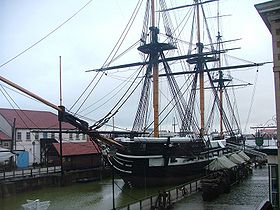HMS Trincomalee

|
|
| Overview | |
|---|---|
| Type | Frigate (sailing ship) |
| Shipyard |
Bombay ( Mumbai ) |
| Keel laying | April 25, 1816 |
| Launch | October 12, 1817 |
| 1. Period of service |
|
| Commissioning | July 23, 1847 |
| Decommissioning | September 1857 (as an active warship) |
| Whereabouts | Museum ship in the Historic Dock , Hartlepool |
| Technical specifications | |
| length | |
| width |
39 ft 11 in (12.18 m) |
| speed |
12 kn |
| Armament |
28 × 18 pounder cannons |
HMS Trincomalee is a frigate built for the Royal Navy in 1817 . Along with HMS Unicorn , USS Constellation and USS Constitution, she is the only remaining frigate from the age of sailing warships and the oldest still floating ship in Great Britain.
The Trincomalee is one of the frigates of the successful and numerous British Leda class, which also include HMS Shannon and HMS Unicorn . The class was built along the lines of the French Hebé , which fell into British hands as a prize in 1782 . The Trincomelee was one of 15 copies of the original design of the Leda class. By 1832 another 25 round-tail ships had been launched. The unicorn belongs to the latter variant .
The Trincomalee is 150 British feet long, 40 wide, and was originally classified as a 46-gun frigate. As armament, 28 18-pounder cannons were provided on the battery deck, 16 32-pounder carronades and 4 9-pounder cannons on the forecastle and aft deck (a total of 48, two guns more than according to the nominal classification).
history
The Trincomalee was built at the Bombay Dockyard in Bombay in 1817 due to a lack of timber in Britain at the time due to the Napoleonic Wars .
The ship was named after the battle of the Ceylonese city of Trincomalee , which took place in 1782 between a British and a French squadron.
After its completion in 1818, the Trincomalee was transferred to England, where it arrived at Spithead on March 29, 1819. Upon arrival, the ship was rigged, provided with a protective roof and put in reserve. The Trincomalee was not activated as a warship until 30 years after it was launched . Although the Trincomalee was built as a frigate, it was too small for this role compared to the current standard of the now much larger and more heavily armed frigates. Therefore she was converted into a corvette and equipped with modern armament. From 1847 to 1850 the ship served on the West Indian and North American stations, from 1852 to 1857 on the Pacific. After returning to England, the Trincomalee was re-launched and served between 1862 and 1895 as a training ship for the Royal Navy.
In 1897 the Trincomalee was supposed to be sold for scrapping. However, the buyer was George Wheatley Cobb, who had it repaired and renamed it in honor of HMS Foudroyant , which was destroyed in 1897. Together with HMS Implacable , she then served as a training ship for young people, with the ship belonging to the Foudroyant Trust from 1959 to 1992 .
From 1990 to 2002 the ship was completely restored and renamed HMS Trincomalee again . It is currently a museum ship in the historic part of the Hartlepool docks . The state of construction and equipment (e.g. the dummy guns) of the restored ship largely correspond to the appearance of a frigate from around 1815. The most noticeable deviation from the original state of construction is the more modern elliptical stern that was installed when the corvette was converted in 1847.
Remarks
literature
- Robert Gardiner: Frigates of the Napoleonic Wars . Chatham Publishing, 2006 (Contains information on the history of the Leda class to which the Trincomalee belonged).
- Andrew Lambert: Trincomalee: the last of Nelson's frigates . Chatham Publishing, 2002, ISBN 1-86176-186-4 .
Web links
- Official website for the Trincomalee
- The Perfection of Wooden Sailing Warships in the Context of 19th Century International Politics ( Memento of September 29, 2007 in the Internet Archive )
Coordinates: 54 ° 41'25.1 " N , 1 ° 12'25" W.
